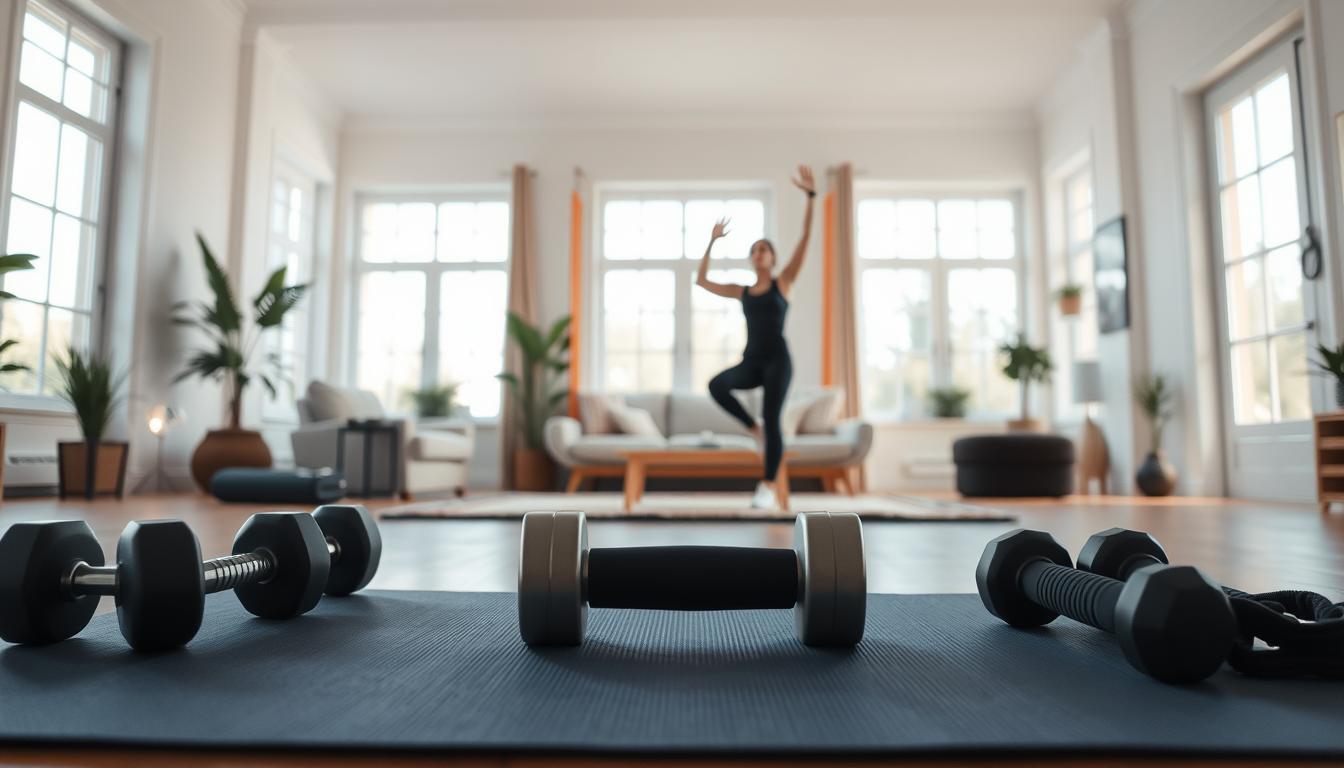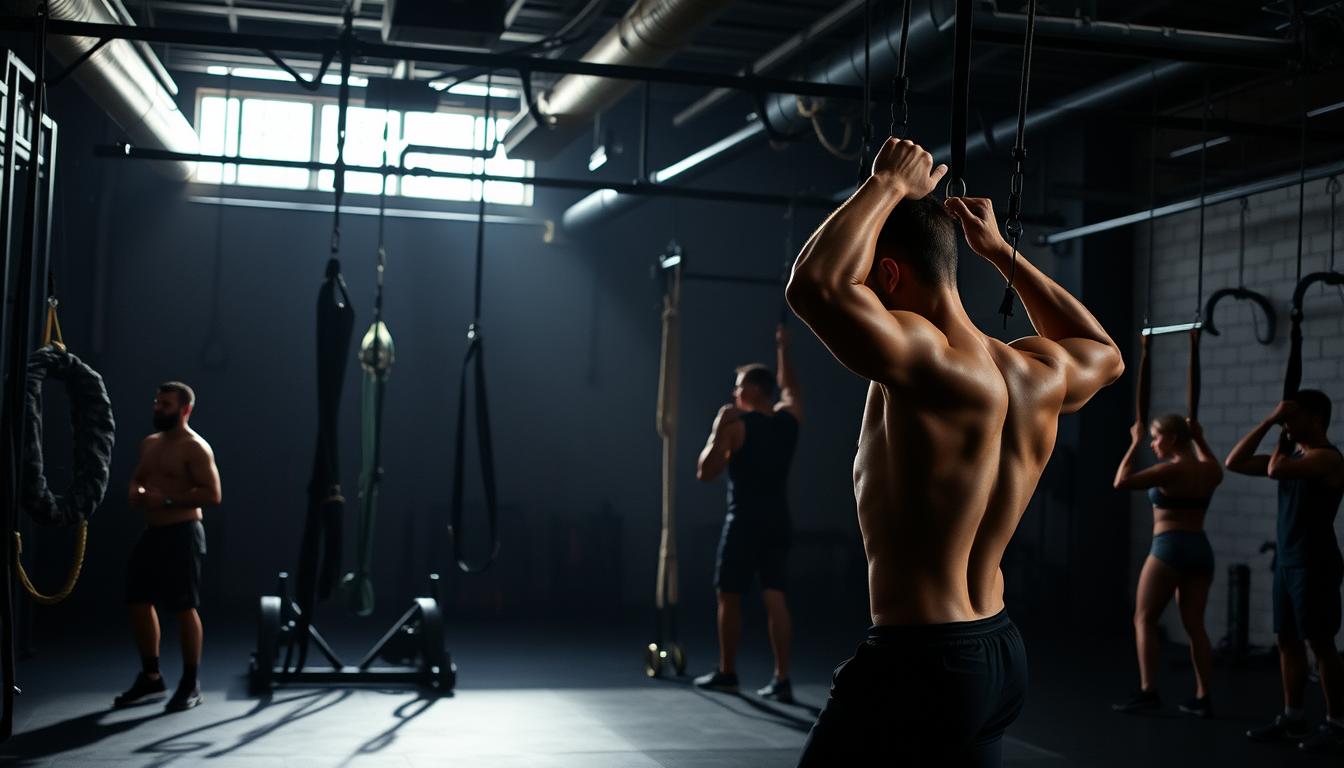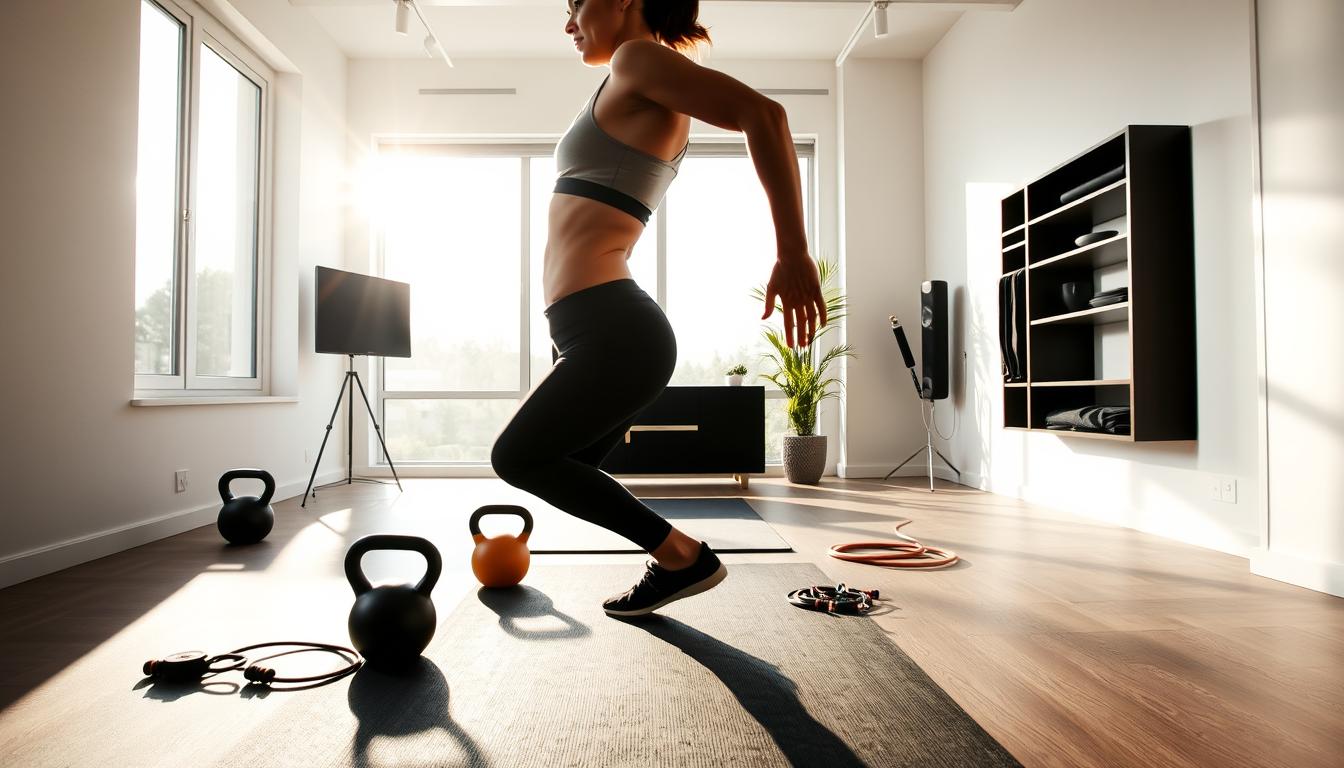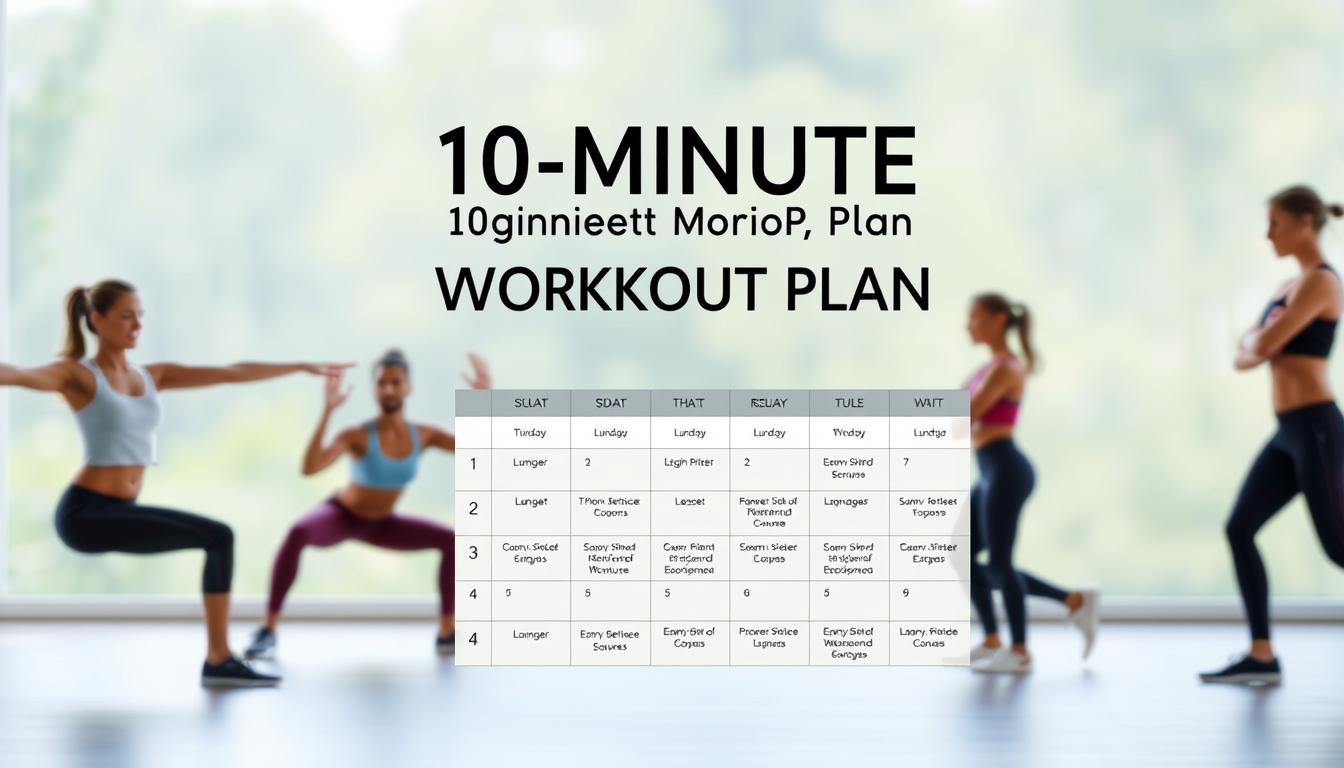Imagine skipping the long commute and crowded gyms. You can still build gym-quality muscle at home. For those with busy lives, home workouts are not just easy—they work. Research shows 85% of people who stick to home routines see strength gains just like gym-goers.
⏳ Get Your Energy Back with Discount!
Certified exercise physiologist Inbar Naor-Maxwell says: “Thirty-minute sessions using proper techniques can reshape your physique as effectively as hour-long gym visits.” The key is choosing the right exercises and increasing the weight or resistance over time.
You don’t need a lot of equipment to get started. Bodyweight exercises, resistance bands, and even household items can help. Naor-Maxwell stresses the importance of safety through professional guidance. Virtual coaching can ensure you’re doing exercises correctly, avoiding injuries while burning calories and building muscle.
Key Takeaways
- 30-minute home workouts match gym session effectiveness when done strategically
- Expert-backed methods require minimal equipment for muscle growth
- Proper form supervision prevents injuries during DIY training
- Bodyweight exercises can be modified for progressive challenges
- Time-efficient routines fit seamlessly into busy schedules
Why Your Living Room Can Be as Effective as a Weight Room
Do you think you need fancy gym equipment to build muscle? Think again. Your body grows muscle through consistent effort, not fancy tools or gym memberships. Whether you’re doing push-ups on carpet or deadlifts with water jugs, it’s all about two key things.
Muscles Don’t Care Where You Train
Your biceps don’t know if you’re using dumbbells or resistance bands. A Physiology & Behavior study showed muscles grow based on mechanical tension and metabolic stress.
The Role of Mechanical Tension & Metabolic Stress
Here’s what really matters:
- Make workouts harder each week (add reps or slow down)
- Reach muscle failure safely
- Keep tension throughout the whole movement
“Muscle growth happens when you challenge yourself more than usual – where you work out doesn’t matter.”
Key Advantages of Home Workouts
Home workouts offer something gyms can’t: daily accessibility. Parents can do squats during naptime. Office workers can fit in drills during the day.
Consistency Beats Occasional Intensity
A Kennesaw State University study found people work out 63% more at home than at the gym. Why? No commute, no waiting for equipment, and no excuses.
| Factor | Home Workouts | Gym Workouts |
|---|---|---|
| Average weekly sessions | 5.2 | 2.8 |
| Time per session (mins) | 27 | 52 |
| Annual cost | $0-$300 | $600-$1200 |
This data shows why micro-workouts – short, 10-15 minute sessions at home – often lead to better results than long gym sessions. Your living room becomes a 24/7 gain zone you actually use.
3 Ways to Train at Home and Build Muscle Like You’re at the Gym
You don’t need fancy equipment to get ripped. Your home can be a muscle-building powerhouse with the right strategies. These three methods deliver gym-level results without leaving your house.
1. Bodyweight Progression System
Your body is the ultimate resistance tool – when you know how to use it. Forget basic push-ups; it’s time to level up.
Time Under Tension Techniques
Slow reps boost muscle fiber activation. Try these tweaks:
- 4-second lowering phase in pull-ups
- 3-second pause at the bottom of squats
- Explosive push-up launches (catch air!)
Advanced Moves: Archer Push-Ups, Single-Leg Glute Bridges
Rotate your shoulders to 45° during archer push-ups for maximum chest engagement. Single-leg glute bridges add serious burn – hold a textbook for extra resistance.
Sample Routine: 45-Minute Full Body Circuit
- Warm-up: 5 min dynamic stretching
- Circuit (repeat 4x):
- 10 archer push-ups per side
- 15 single-leg glute bridges
- 20 plyo lunges
- Cool-down: 5 min foam rolling
2. DIY Weight Solutions That Actually Work
No dumbbells? No problem. Household items become instant gym equipment with these hacks.
Gallon Jug Shoulder Press (40 lbs when full)
Fill two jugs with water or sand for shoulder presses. Pro tip: Use milk jug handles for better grip during lateral raises.
Textbook Deadlifts for Posterior Chain
Stack hardcover books in a sturdy backpack. Maintain neutral spine while lifting – pretend you’re picking up fragile glassware.
Creating Progressive Overload with Household Items
Increase difficulty weekly:
- Add 1/2 cup sand to water jugs
- Use thicker books
- Shorten rest periods by 15 seconds
3. Digital Training Partners
Transform your phone into a personal coach with these virtual gym experience enhancers.
Best Apps: FitBod, JEFIT, Peloton Strength
FitBod’s AI adjusts workouts based on your available equipment. JEFIT tracks every rep – their exercise library shows proper form for 1,400+ moves.
Virtual Spotter Features Explained
Apps like Peloton Strength use motion sensors to:
- Detect shaky form
- Suggest weight adjustments
- Count reps aloud
Mirror Workout Tech for Instant Feedback
Smart mirrors project real-time form corrections onto your reflection. It’s like having a trainer inside your wall – minus the monthly fees.
Maximizing Results Beyond the Workout
Building muscle at home is more than just doing exercises. Your kitchen and bedroom play big roles too. Studies show that 45% of your progress comes from how well you recover and eat. Let’s explore how to fuel your gains and recharge better.
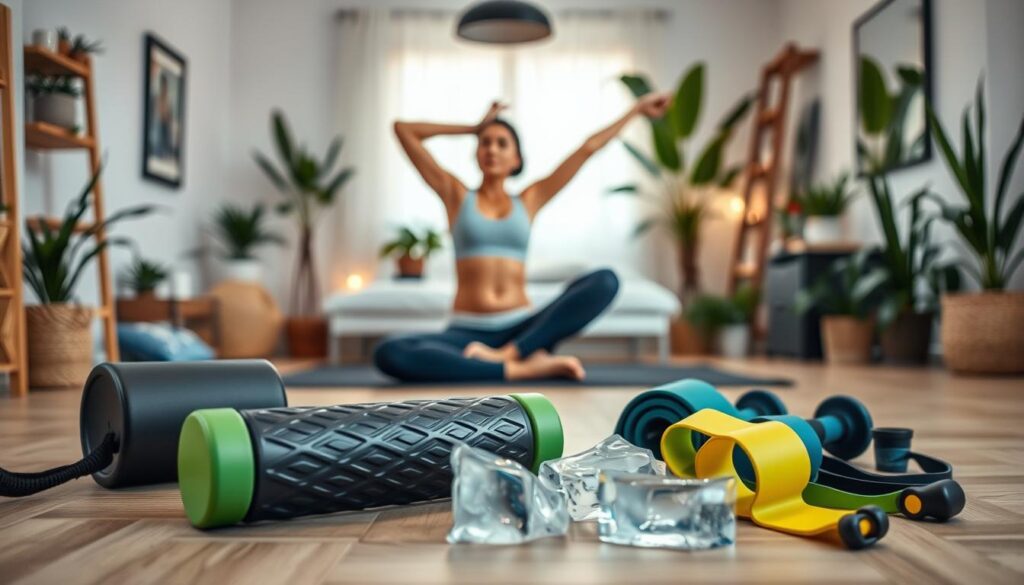
Meal Prep for Home Lifters
Your slow cooker can be a key tool for muscle growth. Cook 5 lbs of shredded chicken while you work out—it’s ready for your post-workout meal. Try these fast, high-protein recipes from Men’s Health:
Protein-Packed 15-Minute Recipes
| Meal | Ingredients | Protein (g) |
|---|---|---|
| Greek Yogurt Bowl | Greek yogurt, berries, almonds | 32 |
| Egg Wrap | Egg whites, spinach, whole-grain tortilla | 24 |
| Cottage Cheese Toast | Whole-grain bread, cottage cheese, chili flakes | 18 |
Sleep Optimization for Muscle Repair
Piedmont Healthcare suggests keeping your bedroom at 68°F for best recovery. Here are some science-backed tips:
- Eat magnesium-rich snacks like pumpkin seeds 1 hour before bed
- Use blackout curtains to block artificial light
- Set a 7-day sleep schedule (even weekends!)
By combining smart training at home with effective recovery, you’ll see results faster than you think.
Conclusion
Building strong muscles doesn’t need fancy gym equipment. Brad Schoenfeld, an exercise physiologist, says: “Progressive overload drives adaptation, whether you’re using barbells or bodyweight exercises.” Your living room can be a gym with consistent effort.
Begin with three weekly circuits from the methods mentioned. Track your push-up progress, add weights to DIY sandbags, or follow Nike Training Club sessions. Thousands have built strong bodies using these methods.
Make sure to eat protein-rich meals and get 7-9 hours of sleep. Muscle grows when you rest, not just when you exercise. Ready to start? Grab a water bottle, start your Apple Fitness+ strength session, and watch your progress grow.
FAQ
Can home workouts really build as much muscle as gym sessions?
How do I safely create weights without gym equipment?
What’s the best app for tracking home workout progress?
How can I maximize muscle growth with limited time?
What should I eat for home workout recovery?
How does sleep quality affect home training results?
Are bodyweight exercises effective for serious muscle growth?
How often should I train each muscle group at home?
Did you like this article? See also: 5 Quick Workouts to Burn Belly Fat Without Leaving Home

